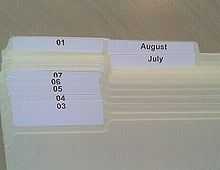Tickler file

A tickler file is a collection of date-labeled file folders organized in a way that allows time-sensitive documents to be filed according to the future date on which each document needs action. Documents within the folders of a tickler file can be to-do lists, pending bills, unpaid invoices, travel tickets, hotel reservations, meeting information, birthday reminders, coupons, claim tickets, call-back notes, follow-up reminders, maintenance reminders, or any other papers that require future action. Each day, the folder having the current date is retrieved from the tickler file so that any documents within it may be acted on. Essentially, a tickler file provides a way to send a reminder to oneself in the future—"tickling" one's memory.
A tickler file system also has other applications such as museum guides, specialized fact books, time management software, or any organized arrangement of information to which a person may want quick access.
History
One common implementation was in law offices in the early twentieth century, if not before, where small task cards or "tickler cards" would be filed by date and then distributed to lawyers as legal tasks such as renewal of trademarks, updating of wills and filing of motions for a particular case would be approaching. In larger firms a single person would be assigned the maintenance and follow-up of this file, distributing tasks and ensuring their follow-up, which could be recorded on the cards for billing and documentation.
More recently the concept was re-introduced to popular culture through various self-help books as Pam Young and Peggy Jones' 1977 book Sidetracked Home Executives: From Pig-Pen to Paradise, FlyLady Marla Ciley, Chris Crouch's book Getting Organized, David Allen's 2002 book Getting Things Done and Merlin Mann's website 43 Folders, whose name comes from one popular method for maintaining a tickler file.
Modern tickler files are often electronic and now fulfilled via software programmed for automatic reminders and tracking.
43 divisions
In larger institutional uses, a tickler file would be chronological, with one section for each year or day, sometimes encompassing more than a century in as much detail as appropriate (especially for dates far in the future). A more common technique is to have index cards with forty-three dividers or a system with forty-three folders or two accordion files. The forty-three divisions come from a maximum thirty-one days in a Gregorian or Julian month and twelve months in a year. When something is scheduled for the coming month, it is placed within the appropriate daily section. Items which need to be done in a particular month are placed in one of the corresponding monthly folder, to be distributed in days near the beginning of that month. Tasks which are not completed may be moved to a different folder or kept in position to be revisited in the following month or year.
Simple systems which involve many repetitive tasks over time tend to use and re-use index cards of an appropriate size, with more complex systems using expandible "accordion files," file folders or even entire rooms full of filing cabinets. Modern systems are usually maintained in computerized databases or with simple tools such as a Unix ".calendar" file.
See also